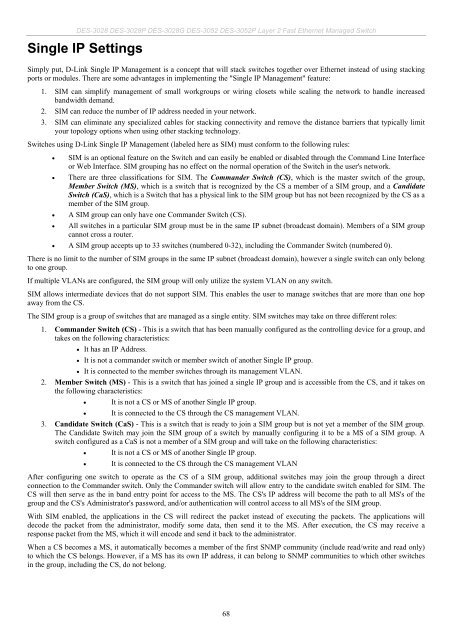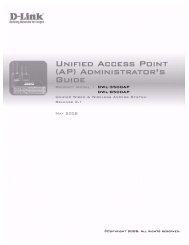Download - D-Link
Download - D-Link
Download - D-Link
You also want an ePaper? Increase the reach of your titles
YUMPU automatically turns print PDFs into web optimized ePapers that Google loves.
DES-3028 DES-3028P DES-3028G DES-3052 DES-3052P Layer 2 Fast Ethernet Managed Switch<br />
Single IP Settings<br />
Simply put, D-<strong>Link</strong> Single IP Management is a concept that will stack switches together over Ethernet instead of using stacking<br />
ports or modules. There are some advantages in implementing the "Single IP Management" feature:<br />
1. SIM can simplify management of small workgroups or wiring closets while scaling the network to handle increased<br />
bandwidth demand.<br />
2. SIM can reduce the number of IP address needed in your network.<br />
3. SIM can eliminate any specialized cables for stacking connectivity and remove the distance barriers that typically limit<br />
your topology options when using other stacking technology.<br />
Switches using D-<strong>Link</strong> Single IP Management (labeled here as SIM) must conform to the following rules:<br />
SIM is an optional feature on the Switch and can easily be enabled or disabled through the Command Line Interface<br />
or Web Interface. SIM grouping has no effect on the normal operation of the Switch in the user's network.<br />
There are three classifications for SIM. The Commander Switch (CS), which is the master switch of the group,<br />
Member Switch (MS), which is a switch that is recognized by the CS a member of a SIM group, and a Candidate<br />
Switch (CaS), which is a Switch that has a physical link to the SIM group but has not been recognized by the CS as a<br />
member of the SIM group.<br />
A SIM group can only have one Commander Switch (CS).<br />
All switches in a particular SIM group must be in the same IP subnet (broadcast domain). Members of a SIM group<br />
cannot cross a router.<br />
A SIM group accepts up to 33 switches (numbered 0-32), including the Commander Switch (numbered 0).<br />
There is no limit to the number of SIM groups in the same IP subnet (broadcast domain), however a single switch can only belong<br />
to one group.<br />
If multiple VLANs are configured, the SIM group will only utilize the system VLAN on any switch.<br />
SIM allows intermediate devices that do not support SIM. This enables the user to manage switches that are more than one hop<br />
away from the CS.<br />
The SIM group is a group of switches that are managed as a single entity. SIM switches may take on three different roles:<br />
1. Commander Switch (CS) - This is a switch that has been manually configured as the controlling device for a group, and<br />
takes on the following characteristics:<br />
It has an IP Address.<br />
It is not a commander switch or member switch of another Single IP group.<br />
It is connected to the member switches through its management VLAN.<br />
2. Member Switch (MS) - This is a switch that has joined a single IP group and is accessible from the CS, and it takes on<br />
the following characteristics:<br />
It is not a CS or MS of another Single IP group.<br />
It is connected to the CS through the CS management VLAN.<br />
3. Candidate Switch (CaS) - This is a switch that is ready to join a SIM group but is not yet a member of the SIM group.<br />
The Candidate Switch may join the SIM group of a switch by manually configuring it to be a MS of a SIM group. A<br />
switch configured as a CaS is not a member of a SIM group and will take on the following characteristics:<br />
It is not a CS or MS of another Single IP group.<br />
It is connected to the CS through the CS management VLAN<br />
After configuring one switch to operate as the CS of a SIM group, additional switches may join the group through a direct<br />
connection to the Commander switch. Only the Commander switch will allow entry to the candidate switch enabled for SIM. The<br />
CS will then serve as the in band entry point for access to the MS. The CS's IP address will become the path to all MS's of the<br />
group and the CS's Administrator's password, and/or authentication will control access to all MS's of the SIM group.<br />
With SIM enabled, the applications in the CS will redirect the packet instead of executing the packets. The applications will<br />
decode the packet from the administrator, modify some data, then send it to the MS. After execution, the CS may receive a<br />
response packet from the MS, which it will encode and send it back to the administrator.<br />
When a CS becomes a MS, it automatically becomes a member of the first SNMP community (include read/write and read only)<br />
to which the CS belongs. However, if a MS has its own IP address, it can belong to SNMP communities to which other switches<br />
in the group, including the CS, do not belong.<br />
68
















